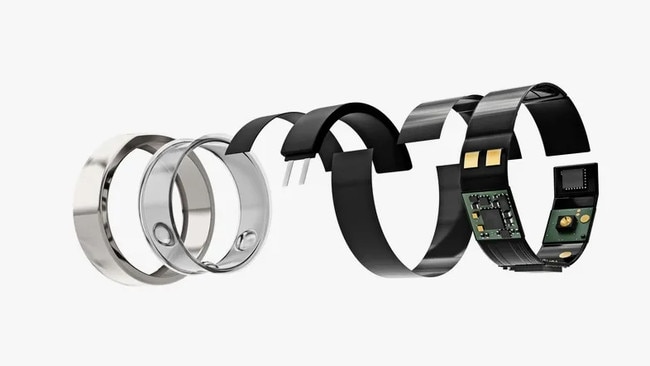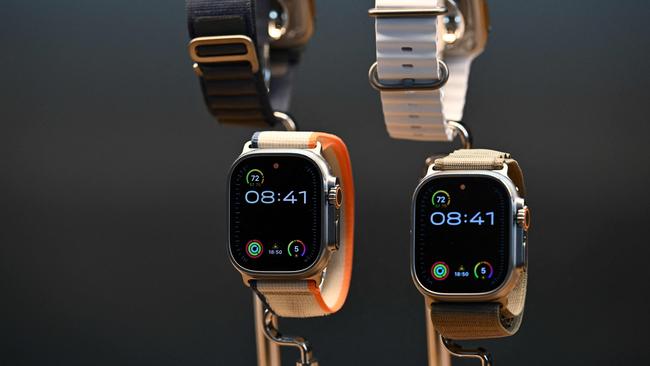The high-tech gadgets putting health in our hands
Wearable tech offers the ultimate in digital navel gazing. But the health data we gather about ourselves has the potential to do much more than we realise.

Ask a centenarian for their longevity secret and it’s doubtful they will mention their daily step count. Nor are those famously long-living Blue Zone inhabitants likely to wax lyrical about sleep stats. But for many of us, wearable technology has become an essential tool in our self-care kit, giving us real-time insights into our habits and feedback on where there is room for improvement or cause for concern.
According to a report by US market intelligence and advisory firm Mordor Intelligence, the Australian wearables market is expected to grow from $US3.13 billion in 2023 to $US5.73 billion by 2028. Since the “Quantified Self” movement emerged about a decade ago, the health data collected by wearables such as smart watches, wrist bands, rings, headsets and connected devices such as smart bathroom scales, has come a long way. At Germany’s Lanserhof Sylt medical spa, guests can road test FreshBed mattresses, which are fitted with medical-grade HEPA-13 filters inside the base and technology that enables individual regulation of body temperatures during rest.
Many of the latest devices are actually tiny computers equipped with GPS, bioactive sensors and near-field communication (NFC), as the big tech companies become increasingly fixated on tracking and enhancing our wellbeing – case in point, Google’s acquisition of fitness tracking company Fitbit for $US2.1 billion in 2019, and the Oura Ring, seen on everyone from Prince Harry and Kim Kardashian to Gwyneth Paltrow since its debut in 2015. Apple Watch accounts for almost 50 per cent of local wearable-tech sales, followed by Fitbit and then Samsung’s Galaxy Watch and Garmin, according to Statista. The health metrics these wearables can now measure (with varying degrees of accuracy) range from basic activity, sleep cycles and stress levels to heart rate variability, metabolic rate, blood oxygen saturation, skin temperature, fall detection, menstrual cycles and more.

Then there are the continuous glucose monitors (CGMs) – minimally invasive patches worn on the upper arm – adopted by diabetic patients to monitor their blood sugar levels. CGMs are increasingly sought out by non-diabetics wanting to gain insights into how their diet, sleep, exercise and stress affects blood glucose levels throughout their day. In 2023, Apple added new mental health features in its watchOS 10 software update which enables users to scroll through dynamic coloured shapes to log their momentary emotions or moods and the factors contributing to those feelings. Users are also able to answer a set of questions on the Apple Health App (similar to those used in clinical settings) to see their current risk of depression or anxiety and identify if they may need to talk to a health professional.
Apple says the aim is to build emotional awareness and resilience, “to empower you to care for your mind just as you do your body”. Apple Watch has also added a focus on vision health to help prevent nearsightedness, or myopia (which typically begins in childhood), via an ambient light sensor that alerts parents when children need to spend more time outdoors. (The International Myopia Institute recommends children spend 80 to 120 minutes a day outside). And it includes a new screen distance feature to encourage users to move their device farther away after holding it closer than 30 centimetres for too long. Another new device is the Withings U-Scan, a “miniaturised in-home health lab that unlocks a wealth of information in daily urine”. The U-Scan is mounted within your toilet bowl for hands-free urine sampling and sends analysis to an app via wifi. Proving just how intimately our devices are getting to know us, U-Scan’s Stream ID feature “can identify an individual by tracking their unique urine stream signature”.
The device, which will be released later this year, comes with two types of cartridges to measure either hydration and nutrition, or female menstrual cycles. This hormone-focused cartridge will enable fertility tracking and also “cycle syncing”, meaning users can align their diet, exercise, social and work engagements with different phases of their own menstrual cycle. If you believe the hype about wearables and other connected devices, the future of healthcare is in our hands, or at least attached to our wrists (and toilets).
It may well be true, but we are not quite there yet. While consumers are busy gamifying health and fitness and gathering data about themselves, their health practitioners are not necessarily going to use those insights anytime soon. General practitioner and part-time software developer Dr Kean-Seng Lim says there are several reasons mainstream medicine has been slow to embrace wearable tech and patient-gathered health data, citing widely variable accuracy, lack of training in health tech and funding hurdles. For example, the current healthcare system is designed around doctors and medical teams charging for consultations, not remote monitoring of patient data.
But wearables can help initiate important conversations between patients and their doctors which then lead to further investigation, says Lim who cofounded a software platform to collate and monitor patient data on a digital dashboard, which is used at his Western Sydney practice. Knowing what to measure is also important. Lim says insights from wearables are only helpful if they are prompting relevant questions based on individual risk factors, current health conditions and family history. “If I want to be as healthy as I can be, then what information do I need?” he questions, adding that doctors can then guide patients on what to do next.

While wearables are popular for counting steps and sleep, few people understand their potential for transforming our understanding of how everyday activity influences health, says Emmanuel Stamatakis, professor of physical activity, lifestyle and population health at the University of Sydney’s Charles Perkins Centre. “If you ask someone how much exercise they did today, they will answer none if they missed the gym at lunchtime but their fitness tracker may tell a very different story,” Professor Stamatakis says. “The device will pick up the short bursts of physical activity, for example when they run for the train or power walk to work. “The use of wearable devices in research, paired with rapidly developing AI, allows us to unlock how these micropatterns of daily activity relate to a person’s risk of premature death, cardiovascular disease and even cancer. It’s an exciting time to be working in this area of research.”
However, he says there are challenges, including a lack of standardisation between data and devices. While consumer devices are frequently upgraded, scientific studies need to use research-grade accelerometers for consistency and evolve at a much slower pace. Other issues to be overcome include how to safely transfer data from individual devices to medical records, security, privacy and IT capabilities. Stamatakis says industry and academics will need to work together more in the future to address consistency and capability for monitoring health behaviours at a population level.
To accelerate the evolution of research-grade wearable hardware, the University of Sydney recently launched the MacKenzie Wearables Research Hub. “The research cycle can be slow but that’s not an option here,” he says. “We have to adapt and move quickly if we are going to make the most of the opportunities wearables present or be prepared to miss the train.”
This story appears in the February issue of WISH Magazine, on sale Friday February 2 inside The Australian.

To join the conversation, please log in. Don't have an account? Register
Join the conversation, you are commenting as Logout